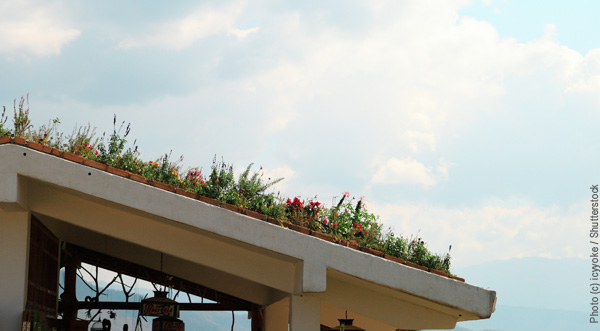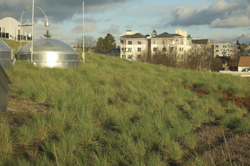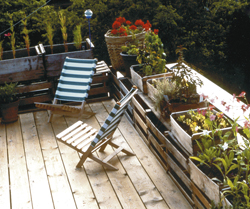Green Roofs: A Growing Rooftop Resource
by Monica E. Kuhn
The next time you walk through your city, look up towards the rooftops. I think you will be surprised at the hints of green and growing things you can see!

Rooftops are a city's greatest untapped resource. Sloped or flat, large or small, industrial or residential, the possibilities for urban greening, air cleaning, community building and food production are limitless. Cover a roof with plants and you have immediately achieved several things. Environmentally, by increasing the city's biomass, you have increased oxygen levels in the air – and decreased the amount of CO2, which is produced by cars and other fuel burning technologies. You have cut down on dust and air-borne particulates, since plants act as natural filters. You have had a hand in altering the local climate, because plants absorb rather than reflect heat. And because roots hold and absorb water, every time it rains your roof is retaining storm water runoff, thereby decreasing the load on the city's storm sewage systems.
Your building – and therefore your pocketbook – will also benefit. Layers of soil and foliage have wonderful insulating qualities, keeping your building warmer in winter and cooler in summer – thereby reducing your energy bills. Because the extreme temperature swings – and therefore the expansion and contraction experienced by the roof – will be moderated, the life span of your roofing membrane will increase. And since the roofing will be covered, the membrane will be protected from harmful UV rays, and from everyday wear and tear.
| In Europe and Asia, rooftops are viewed as much more than inaccessible tar and gravel deserts dotted with drains, vents and condenser units. |
Would you like to know more benefits? Grow vegetables and you can feed your family; grow flowers and you can attract butterflies. Create a safe, private, outdoor space in the heart of the city, without having to buy extra land. Give the people next door a better view. Increase the value of your property. Teach your children about the environment. Increase urban food production. Plant a garden over your apartment. Meet your neighbors ten stories above the street. Trade seeds and gardening ideas. Barter or sell your surplus. Start a small canning business. And make your city beautiful.
And the best thing is that this is not a dream. It is reality. In Europe and Asia, rooftops are viewed as much more than inaccessible tar and gravel deserts dotted with drains, vents and condenser units. In some parts of Germany, new industrial buildings must have green roofs by law. In Swiss cities, regulations now require new construction to relocate to the roof the area of green space covered up by the building's footprint; even existing buildings, some hundreds of years old, must convert 20 percent of their roof space to pasture! This has spawned a whole new industry which specializes in light weight growing mediums, filter cloths, roofing membranes, plant stock and how-to books and kits. Nurseries, designers, consultants and contractors have been forced to relearn and re-adjust in order to compete in the new market, with the result that they now have more and varied work.
Many studies looking into the environmental, financial and social benefits of roof gardens have been completed, and statistics are readily available – if you can read German! However, North Americans are also slowly starting to realize the potential of this “growing” movement. Last year the Danish company Grodania started importing their lightweight rockwool growing medium into Canada, and in September of 1994, the National Roofing Contractors Association in the USA published an article in its magazine Professional Roofing entitled “Designing green roof systems: A growing interest”.
 In reality, the technology and the know-how required to grow plants and trees on elevated structures has existed in Canada and the USA for a long time – just think of all the underground parking garages that support landscaped courtyards; the difference here is that these gardens are at ground level, mimicking a natural situation, and so we don't notice a difference. As well, these gardens were given structural consideration during the initial design phase – not after the fact – whereas most of the roof gardens that people are interested in installing now will have to be retrofits to existing buildings. In reality, the technology and the know-how required to grow plants and trees on elevated structures has existed in Canada and the USA for a long time – just think of all the underground parking garages that support landscaped courtyards; the difference here is that these gardens are at ground level, mimicking a natural situation, and so we don't notice a difference. As well, these gardens were given structural consideration during the initial design phase – not after the fact – whereas most of the roof gardens that people are interested in installing now will have to be retrofits to existing buildings.
If you are interested in growing a green roof, there are several issues that you should be aware of.
The first is loading. Soil, decking, people and plants – and where they are placed on your roof deck – all have an impact on the existing structural/carrying capacity of the roof, as well as that of the rest of the building. It is important to have a structural engineer confirm the additional weight that the roof can accommodate. One cubic foot of wet earth weights around 100 pounds, so you can imagine the additional stresses that gardens can create. However, remember that earth is not soil; you will probably be adding compost, mulch and other fillers which will decrease the weight. Not all of your planting beds have to be 12 inches deep, nor will you be uniformly covering the whole roof surface. Heavy planters can be placed strategically over bearing walls or columns. Grasses don't need more than three inches of growing medium, and some plants will grow in gravel. You have a lot of options available to you. 
The second consideration is safety. How do you access the roof? How do you get materials and water up to the roof? Who will be using the roof? Is there a railing? Are you insured? Requirements, solutions and costs will vary, depending on whether the garden is on a private residence, an apartment tower or a public library. Building codes have specific regulations regarding structural, health and safety issues as they relate to new and existing buildings. A call to your local Building Department or an architect will help to get you started.
Your roofing material itself is also an issue. What kind is it and what condition is it in? Can you walk on it or should it be protected? Will plant roots penetrate the membrane and should you be elevating your plants? How and where does it drain? If you have to replace or repair it in five years, can you do so without disrupting your established garden?
And then there is the specific micro-climate of the roof itself. Gardening up on a roof is quite different from gardening at grade. It is very sunny, sometimes windy, and the temperatures are often extreme. This will have a direct effect on what will grow well, how often you have to water, and whether your plants can survive through the winter. You can temper the effects of heat, cold and dryness by using containers that retain moisture, by insulating your planters, by using mulch, by mixing moisture retaining additives into your soil, by layering or interplanting, by building trellises and shade structures, by collecting rainwater, or by sticking to plants that thrive in these conditions. It is likely to be an ongoing experiment!
The main thing to remember is that each roof is as different as the gardener who uses it. The next time you walk through your city, look up towards the rooftops. I think you will be surprised at the hints of green and growing things you can see!
Monica Kuhn is a registered architect in Toronto, Ontario who specializes in rooftop gardens and Permaculture design. For more information on rooftop gardens, contact Green Roofs for Healthy Cities.
This article was published in Natural Life Magazine in 1995.
|

